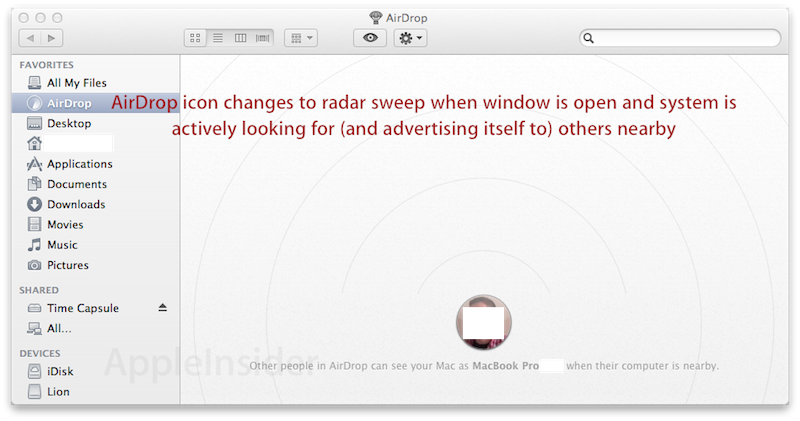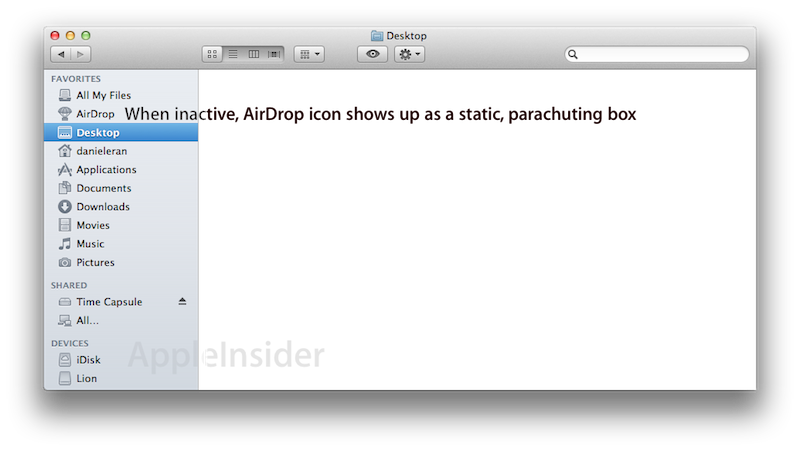Inside Mac OS X 10.7 Lion: AirDrop local file sharing
AirDrop has nothing in common with DropBox, a cloud-based file sharing service more akin to iDisk. Instead, AirDrop allows users to discover nearby users and share files with them directly, without needing to configure a common WiFi network.
For users who are already on the same network, it's long been possible to set up File Sharing, exchange account information and then perform file transfers. However, this involves some relatively complex technical understanding that many users find confusing, despite Apple's efforts to simplify things.
The concept of infrastructure mode networking is similar to meeting people on Facebook, where everyone logs in and can exchange messages easily, even with new people. The problem with this kind of networking, however, is that it requires a sophisticated central entity managing the network, accounts, and all of your shared messages (the job FaceBook does).
If you don't have an established network, you're now in the position of being at a party in a room full of strangers. You'll need to approach people and exchange pleasantries in person, something you won't need the infrastructure of a system like FaceBook to do. Of course, to do this, you'll need to all speak the same language, you might need an introduction, and others will have to want to talk to you.
That type of "ad hoc" networking can already be done between systems using a protocol like Bluetooth, which can introduce two devices and support simple file transfers. Bluetooth is rather slow however, and involves a layer of security that involves a PIN exchange. WiFi is much faster, but users typically use it in "infrastructure" mode, which assumes that you have a central base station negotiating the network transaction for you (and, like Time Capsule, perhaps also providing a shared disk).
Lion's new AirDrop makes basic file exchange between nearby users as simple as Bluetooth, as fast as WiFi, and as easy as drag and drop, with layers of security and personalization that combine with Apple's easily understandable user interface to make a conceptually complex task easy to initiate even for non technical users.
Three similar solutions
There's already a couple emerging standards aiming to do what AirDrop does. The developers of Bluetooth (which functions like a wireless USB link) have released Bluetooth 3.0+HS, which speeds up Bluetooth file transfers by initiating a connection over Bluetooth and then switching to WiFi to actually send the data.
The developers behind WiFi (which is expressly designed to provide wireless networking rather than being intended to support wireless peripherals like Bluetooth) have codified WiFi Direct, a new protocol that allows a WiFi enabled device to act more like Bluetooth on the side: finding other devices, establishing a temporary secure link, and then supporting direct file transfers or printer connections, for example.
Apple's AirDrop isn't based on either protocol, but works similar to WiFi Direct. It allows Macs (and likely in the future, iOS devices) to discover nearby systems capable of AirDrop, negotiate a secure ad hoc connection via WiFi (even if both systems are already connected to different WiFi base stations), then presents a simple interface that depicts each discovered user, allowing for files to simply be dropped on an icon to begin a transfer. The receiving user only needs to accept the transfer. It's as simple as shaking hands with a stranger.
AirDrop vs Bonjour
Note that Apple's Bonjour technology (formerly called Rendezvous) does something different: it helps systems on the same local (infrastructure mode) network to advertise and discover available services (such as shared printers, iTunes or iPhoto libraries, or Apple File Server shares), without having to manually configure a centralized DNS to allow finding what's available.
AirDrop works a bit like Bonjour without an existing network, enabling discovery of non-networked systems available and willing to set up a temporary connection. AirDrop's technology is currently used solely for file transfers in the Finder, but it is potentially useful for a variety of tasks (including printing or trading contacts), especially on mobile devices.
It appears AirDrop acts like a Bonjour for SSID (WiFi network name) advertisements which other WiFi interfaces can browse and connect to, as opposed to the traditional Bonjour role of AppleTalk-like IP DNS advertisements on an established network.
How AirDrop works in the Lion Finder
Using AirDrop is simple: you click on the Finder Sidebar's AirDrop icon and it begins displaying all of the nearby systems prepared to AirDrop. While active, the Airdrop icon changes from a parachuting package into an animated radar sweep to let you know its actively looking for available nearby drop targets (below).
To show up in the Finder's AirDrop window, other nearby systems will need to be running Mac OS X Lion; using a supported WiFi interface (only fairly recent Macs do); and also have their Finder's AirDrop window open.
The fact that all parties must have AirDrop open to be visible to others prevents the potential for opportunistic spammers or malicious users to bombard everyone nearby with requests to download their files. You have to intentionally open up hailing frequencies before AirDrop will even put you on the radar of other nearby systems. When you're finished, simply closing the Finder's AirDrop window (or changing the active window to another Finder location) again removes your system from view by nearby users, returning the AirDrop icon to its static form (below).
Apple badges known users with their photos from your contacts, so you get an easy to use representation of who you're dealing with when multiple people are all performing AirDrop sessions at the same time.
While it certainly won't be impossible to attempt to exploit AirDrop file transfers, it will be much easier for even non-technical users to spot suspicious activity when setting up a file transfer. And there's no need for Bluetooth PIN codes, file sharing accounts, or other confusing steps. Just open a window and everyone you might want to interact with pops up.
AirDrop support
The biggest issue with AirDrop seems to be finding compatible hardware. It does not appear to be supported by Macs using Atheros WiFi interfaces, as AirDrop didn't show up on a Late 2006 MacBook Pro 2,2. It also didn't seem to work on a Early 2009 Mac mini 3,1 using Broadcom's "Airport Extreme (0x14E4, 0x90)" WiFi chip. Both models should be officially supported by Lion, both support 802.11n and both use Core 2 Duo CPUs.
AirDrop did show up on a mid 2010 Core i5 MacBook Pro 6,1 using a Broadcom "Airport Extreme (0x14E4, 0x93)" WiFi interface card similar but not identical to the two year old Mac mini. The newest Early 2001 MacBook Pro 8,1 with Sandy Bridge CPUs are unable to run the existing Lion Developer Preview, which came out before they were released.
It's possible Apple could issue new firmware that potentially could broaden the number of machines than can support AirDrop. Of course, what really matters is whether older WiFi chips have any potential to support the WiFi Direct-like ad hoc mode networking while also connected to another network.
Notably, machines earlier than Mid 2010 MacBook Pros are listed as supporting "802.11 draft n," as opposed to the post-draft status of the only machine we saw AirDrop working on.
Readers running Lion can report whether AirDrop shows up on their model, and AppleInsider will update this report. Machines that can run Lion but can't (currently) support the AirDrop feature simply lack an AirDrop Finder Sidebar icon, nor any option in Finder Preferences to turn it on or off (shown below).
AirDrop certainly won't work on machines without WiFi, but all modern Macs, even the Mac Pro, now include WiFi interfaces.
The "Air" name, similar to AirPlay and AirPrint, suggests Apple will also add AirDrop support to iOS devices as well, which would certainly benefit from an easy way to move files between themselves and desktop computers without resorting to using email attachments or the somewhat obtuse iTunes File Sharing feature.
 AppleInsider Staff
AppleInsider Staff












 Mike Wuerthele
Mike Wuerthele

 Malcolm Owen
Malcolm Owen
 Chip Loder
Chip Loder

 William Gallagher
William Gallagher
 Christine McKee
Christine McKee
 Michael Stroup
Michael Stroup







